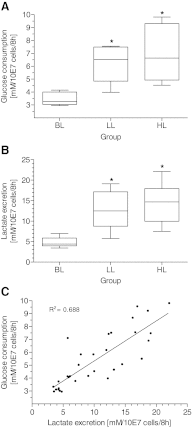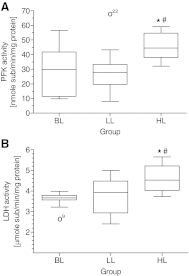Heat shock protein 70 (Hsp70) inhibits oxidative phosphorylation and compensates ATP balance through enhanced glycolytic activity
- PMID: 23042904
- PMCID: PMC3570964
- DOI: 10.1152/japplphysiol.00658.2012
Heat shock protein 70 (Hsp70) inhibits oxidative phosphorylation and compensates ATP balance through enhanced glycolytic activity
Abstract
To address possible effects of heat shock protein 70 (Hsp70) on energy metabolism, we established a cell line expressing different levels of Hsp70 and evaluated changes in glucose and lactate metabolites, as well as ATP levels accordingly. In addition, activities of enzymes involved in glycolysis [phosphofructokinase (PFK) and lactate dehydrogenase (LDH)], Krebs cycle [citric synthase (CS)], and oxidative phosphorylation {NADH dehydrogenase [complex I (CI)] and ubiquinol:cytochrome-c reductase [complex III (CIII)]} were analyzed. The results show that both glucose consumption and lactate excretion were elevated significantly in cells expressing increased levels of Hsp70. Simultaneously, the activities of glycolytic enzymes PFK and LDH were increased markedly in cells overexpressing Hsp70. Activities of enzymes CI and CIII, both involved in oxidative phosphorylation, decreased upon increased expression of Hsp70. These findings were supported by nonsignificant reductions of CS activities in cells that overexpressed Hsp70, whereas intracellular ATP levels remained constant over a wide range of Hsp70 expression. In conclusion, overexpression of Hsp70 in HeLa cells results in downregulation of oxidative phosphorylation, in particular, multiprotein CIII, the main source of reactive oxygen species. In exchange, upregulation of the glycolytic pathway compensates for the homeostasis of cellular ATP supply.
Figures







Similar articles
-
The cellular and compartmental profile of mouse retinal glycolysis, tricarboxylic acid cycle, oxidative phosphorylation, and ~P transferring kinases.Mol Vis. 2016 Jul 23;22:847-85. eCollection 2016. Mol Vis. 2016. PMID: 27499608 Free PMC article.
-
Copper effects on key metabolic enzymes and mitochondrial membrane potential in gills of the estuarine crab Neohelice granulata at different salinities.Comp Biochem Physiol C Toxicol Pharmacol. 2012 Nov;156(3-4):140-7. doi: 10.1016/j.cbpc.2012.08.001. Epub 2012 Aug 7. Comp Biochem Physiol C Toxicol Pharmacol. 2012. PMID: 22892099
-
α-Lactalbumin-oleic acid complex kills tumor cells by inducing excess energy metabolism but inhibiting mRNA expression of the related enzymes.J Dairy Sci. 2018 Jun;101(6):4853-4863. doi: 10.3168/jds.2017-13731. Epub 2018 Mar 15. J Dairy Sci. 2018. PMID: 29550120
-
Heat shock protein 70 and ATP as partners in cell homeostasis (Review).Int J Mol Med. 1999 Nov;4(5):463-74. doi: 10.3892/ijmm.4.5.463. Int J Mol Med. 1999. PMID: 10534567 Review.
-
Rethinking the Citric Acid Cycle: Connecting Pyruvate Carboxylase and Citrate Synthase to the Flow of Energy and Material.Int J Mol Sci. 2021 Jan 9;22(2):604. doi: 10.3390/ijms22020604. Int J Mol Sci. 2021. PMID: 33435350 Free PMC article. Review.
Cited by
-
The heart-brain axis: A proteomics study of meditation on the cardiovascular system of Tibetan Monks.EBioMedicine. 2022 Jun;80:104026. doi: 10.1016/j.ebiom.2022.104026. Epub 2022 May 13. EBioMedicine. 2022. PMID: 35576643 Free PMC article.
-
Upregulation of transcripts for metabolism in diverse environments is a shared response associated with survival and adaptation of Klebsiella pneumoniae in response to temperature extremes.Funct Integr Genomics. 2014 Sep;14(3):591-601. doi: 10.1007/s10142-014-0382-3. Epub 2014 Jun 3. Funct Integr Genomics. 2014. PMID: 24890397
-
Enzyme-Loaded pH-Sensitive Photothermal Hydrogels for Mild-temperature-mediated Combinational Cancer Therapy.Front Chem. 2021 Jul 29;9:736468. doi: 10.3389/fchem.2021.736468. eCollection 2021. Front Chem. 2021. PMID: 34395390 Free PMC article.
-
Suboptimal Mitochondrial Activity Facilitates Nuclear Heat Shock Responses for Proteostasis and Genome Stability.Mol Cells. 2023 Jun 30;46(6):374-386. doi: 10.14348/molcells.2023.2181. Epub 2023 Apr 20. Mol Cells. 2023. PMID: 37077029 Free PMC article.
-
Targeting Cancer Metabolism Breaks Radioresistance by Impairing the Stress Response.Cancers (Basel). 2021 Jul 27;13(15):3762. doi: 10.3390/cancers13153762. Cancers (Basel). 2021. PMID: 34359663 Free PMC article.
References
-
- Atamaniuk J, Stuhlmeier KM, Vidotto C, Tschan H, Dossenbach-Glaninger A, Mueller MM. Effects of ultra-marathon on circulating DNA and mRNA expression of pro- and anti-apoptotic genes in mononuclear cells. Eur J Appl Physiol 104: 711–717, 2008 - PubMed
-
- Beere HM, Wolf BB, Cain K, Mosser DD, Mahboubi A, Kuwana T, Tailor P, Morimoto RI, Cohen GM, Green DR. Heat-shock protein 70 inhibits apoptosis by preventing recruitment of procaspase-9 to the Apaf-1 apoptosome. Nat Cell Biol 2: 469–475, 2000 - PubMed
-
- Beutler E. Red Cell Metabolism: A Manual of Biochemical Methods. New York: Grune & Stratton, 1984
MeSH terms
Substances
LinkOut - more resources
Full Text Sources

